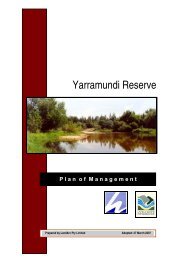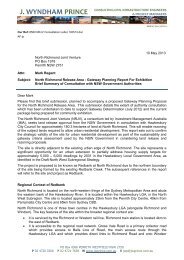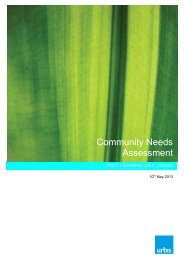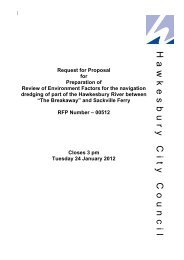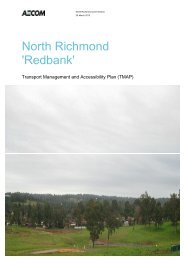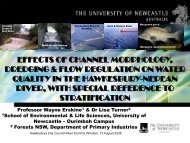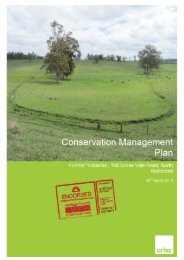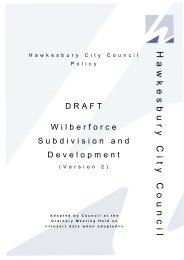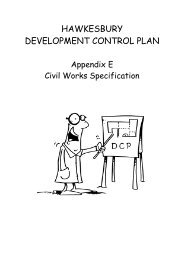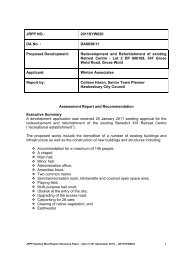Attachment 1 to Item 53 - Roadside Vegetation Management Plan
Attachment 1 to Item 53 - Roadside Vegetation Management Plan
Attachment 1 to Item 53 - Roadside Vegetation Management Plan
Create successful ePaper yourself
Turn your PDF publications into a flip-book with our unique Google optimized e-Paper software.
H AW K E S B U R Y C IT Y C O U N C IL R O AD S ID E V E G E T AT IO N M AN AG E M E N T P L AN<br />
be managed have conditions specified on their Hazard Reduction Certificates which relate<br />
<strong>to</strong> the protection of threatened flora and fauna species, these must be followed;<br />
• Consider the most appropriate fuel reduction method that protects the conservation value<br />
of roadside vegetation and minimises potential impacts <strong>to</strong> weed and soil issues;<br />
• Follow the NSW Bushfire Environmental Assessment Code (RFS 2006), which provides<br />
guidance for the prevention of soil erosion and instability, and protection of riparian buffers,<br />
native vegetation, biodiversity, heritage, other significant environmental protection areas<br />
and weeds; and<br />
• Where slashing is required for Asset Protection Zones (APZ), it should be undertaken on a<br />
yearly basis during autumn or winter and in a manner that enhances growth of indigenous<br />
unders<strong>to</strong>rey and avoids regenerating trees and shrubs.<br />
General recommendations that should be followed in regards <strong>to</strong> fire mitigation works on roadsides for<br />
the protection of biodiversity include:<br />
• Using hygiene practices which prevent the further spread of weed propagules or soil<br />
pathogens (i.e. Phy<strong>to</strong>phthora) at all times;<br />
• Design slashing programs <strong>to</strong> begin with clean machinery in high conservation priority areas<br />
and work <strong>to</strong>wards the more degraded sites <strong>to</strong> prevent the further spread of weeds;<br />
• On high and medium conservation priority roads, slashing is <strong>to</strong> be restricted <strong>to</strong> APZ and<br />
the immediate road verge unless otherwise specified;<br />
• Slashing on low priority conservation roadsides is generally not detrimental; and<br />
• Using information collected through the roadside vegetation surveys, identify the location of<br />
weeds which may produce higher fuel loads (i.e. Coolatai Grass) and take steps <strong>to</strong> remove<br />
and prevent their spread through appropriate weed control programmes.<br />
6.10 EROSION AND SEDIMENTATION, WATER CATCHMENTS AND POLLUTION<br />
Road management activities can increase the level of erosion from roadside environments and lead <strong>to</strong><br />
sedimentation and pollution of water catchments (see Section 3.10). The following actions detail how<br />
roadside environments should be managed <strong>to</strong> minimise erosion, sedimentation and pollution of water<br />
catchments, and habitat degradation.<br />
• Ensure that drains follow natural drainage lines. Avoid steep batters and steep drainage<br />
lines;<br />
• Use rip-rap (i.e. rock structures) lining of drainage lines where necessary;<br />
• Ensure that table drains, culverts and mitre/cut off drains retain some vegetation cover <strong>to</strong><br />
maximize filtering of runoff water, and that soil disturbance is minimal;<br />
• Avoid concentrated flows on<strong>to</strong> adjacent areas as this increases the likelihood of erosion<br />
and poor filtration;<br />
• When constructing or maintaining drains ensure that a wide, shallow profile is created and<br />
maintained. This will reduce water velocities;<br />
• Use energy dissipating devices at outfalls;<br />
• Create artificial wetland areas <strong>to</strong> dissipate flow where possible;<br />
• Capture silt by use of silt traps, silt fencing, barriers, sedimentation ponds or retarding<br />
basins;<br />
• Divert s<strong>to</strong>rmwater away from loose or exposed soil;<br />
• Avoid blocking drainage lines with soil or vegetation s<strong>to</strong>ckpiles or windrows;<br />
• Direct drainage water away from wetland areas <strong>to</strong> avoid contamination and alteration <strong>to</strong><br />
water levels;<br />
© E C O L O G I C AL AU S T R AL I A P T Y L T D<br />
55



